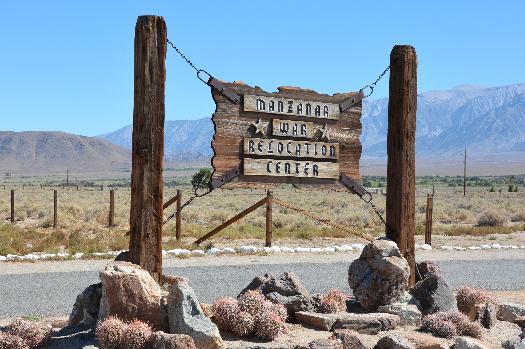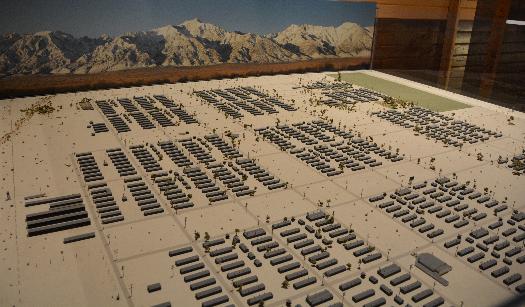
Countercurrents (July 27, 2016)
Z Magazine (September 2016)
Copyright © 2016 by Marc Norton
 |
On the first day of the Republican National Convention, while Republican delegates were arguing about voting rules, and the anti-Trump delegates were being put in their place, I was touring the Manzanar War Relocation Center in the California desert.
An historic marker at the entrance to Manzanar reads, “May the injustices and humiliation suffered here as a result of hysteria, racism and economic exploitation never emerge again.”
Today a Republican Presidential nominee has emerged who revels in racism, hysteria and religious bigotry. “Law and order” is once again the euphemism of the day, whether we are talking about Muslims, Mexican immigrants or Black Lives Matter.
Manzanar, for those who may be a little sketchy on their history, is one of the internment camps set up by the federal government during World War II for US citizens and residents who happened to be of Japanese descent. Manzanar is located in the Owens Valley east of the Sierra Nevada mountains. It is a hot, windy, bleak and unforgiving land, although strangely beautiful. Over 10,000 people – men, women, children, whole families – were ripped from their homes and exiled to Manzanar for the duration of the war. Those 10,000 were only a small fraction of the over 110,000 who were interned at relocation camps around the country.
According to a CBS news report last December, Donald Trump “defended his call to temporarily bar Muslims from entering the United States by comparing it to former President Roosevelt’s 1942 executive order” that set up these internment camps.
“This is a president highly respected by all, he did the same thing,” Trump said on ABC’s Good Morning America.
When Trump was asked if he was proposing setting up internment camps for Muslims, he said “I am not proposing that.” However, Trump refused to say whether or not he would have supported the wartime internment. “I would have had to be there at the time to tell you, to give you a proper answer.”
 Trump elaborated on his view of the internment camps to Time Magazine. “It’s a tough thing. It’s tough. But you know war is tough. We don’t win anymore. We don’t win wars anymore. We’re not a strong country anymore. We’re just so off.” Presumably Trump is going to fix that and “Make America Great Again.” Trump elaborated on his view of the internment camps to Time Magazine. “It’s a tough thing. It’s tough. But you know war is tough. We don’t win anymore. We don’t win wars anymore. We’re not a strong country anymore. We’re just so off.” Presumably Trump is going to fix that and “Make America Great Again.”
Manzanar is now a “National Historic Site,” run by the National Park Service. Nobody, however, could mistake Manzanar for a traditional park, even those who visit other national historic parks in California, such as Fort Point at the foot of the Golden Gate Bridge, or the John Muir National Historic Site in Martinez. Alcatraz is perhaps the most similar kind of park, although Alcatraz was filled with prisoners who were at least given some kind of due process. Alcatraz also held many fewer prisoners than Manzanar.
One of the things that most impressed me about Manzanar is its immense size. There is a driving tour that circumnavigates the camp that put a few miles on my odometer. The size of the camp is roughly comparable to the secure “event zone” that Cleveland officials set up around the Quicken Loans Arena where the Republicans held their coronation. Tourists at Manzanar can now see reconstructed guard towers and barbed-wire fences. Protesters in Cleveland saw lots of heavily armed cops and barricades. Of course, security at Manzanar was organized around keeping people in the camp, while security in Cleveland was organized around keeping people out of the arena.
Roosevelt’s executive order establishing the internment camps was heroically challenged in court by Fred Toyosaburo Korematsu. The case worked its way all the way to the Supreme Court. The Supreme Court upheld Roosevelt’s executive order. That court decision still stands, a fact that Trump may or may not know.
Despite the Supreme Court decision, Japanese prisoners, their friends and allies have fought a long and hard battle for some measure of redress. In 1988 President Ronald Reagan signed a bill apologizing for the internment and paid out some limited compensation to surviving victims. Would Trump have signed the bill that bears the signature of Reagan, the Republican icon? That does not seem likely.
The National Park Service has been gradually restoring parts of Manzanar. This history should not be lost, as painful as it is. Those who fail to study history, it has been famously said, are condemned to repeat it.
Study hard, America.
 |
|